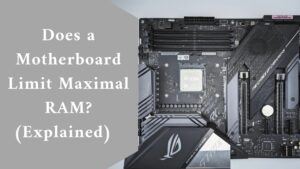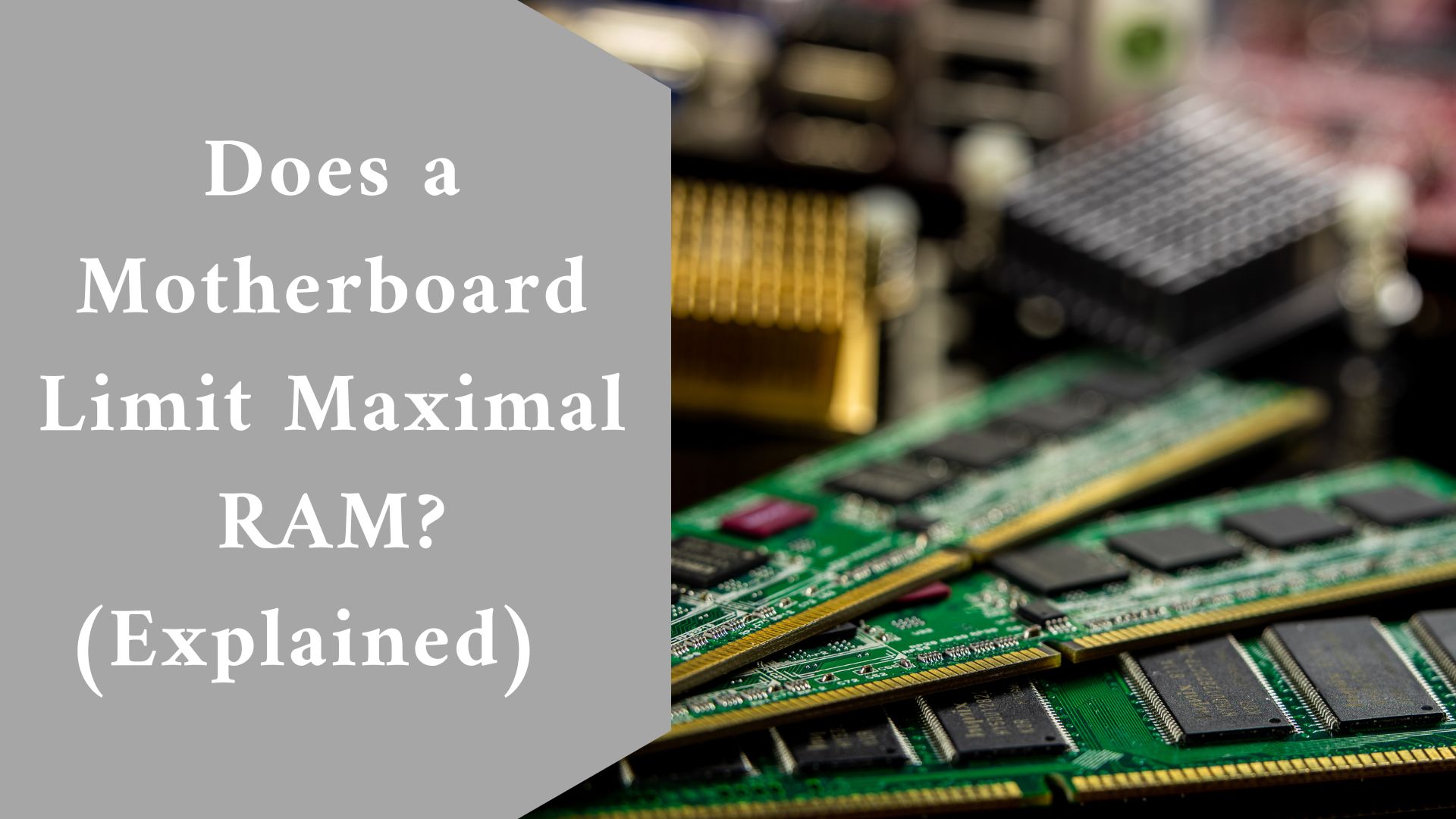Your motherboard can theoretically support an infinite quantity of RAM. In practice, the amount of RAM your motherboard can support is limited. Your motherboard can support 16 GB of RAM if it was manufactured after 2007.
Amount Of RAM Motherboard Can Handle
Random Access Memory (RAM) is the short-term memory of a computer. It is the key to improved performance. Are you thinking of purchasing a new computer? RAM is an excellent place to start. You may even be asking how much RAM your motherboard can support.
Your motherboard can theoretically support an infinite quantity of RAM. In practice, the amount of RAM your motherboard can support is limited. Your motherboard can support 16 GB of RAM if it was manufactured after 2007.
This isn’t a shopping guide, and it only scratches the surface of a complex subject. Nonetheless, it provides a wealth of RAM-related information. So, if you’re curious, keep reading.
To know How Much RAM Your Motherboard Can Support?
RAM is a physical component that stores data momentarily while you use computer programs. More RAM capacity allows you to store more data. As a result, your computer runs quicker.
However, you cannot add an infinite amount of RAM due to physical constraints such as hardware and operating systems.
Each motherboard model will only support a limited amount of RAM. So, before you begin, you should know how much RAM your motherboard can support.
Here are some procedures to take to determine how much RAM your motherboard can support:
-
Determine Whether Your Windows Machine Is 32-bit Or 64-bit:
Windows only support two system architectures: 32-bit and 64-bit. When more RAM is installed than the system can manage, the extra RAM becomes unreadable.
For example, if you add extra RAM to a 32-bit Windows system, the motherboard will not recognize it.
Fortunately, determining whether your Windows is 32-bit or 64-bit is simple. Right-click the “My Computer” icon on the desktop and then select “Properties.”
On Windows 7, navigate to Control Panel > System and Security > System and look for “System type.”
To establish if your Windows is 32-bit or 64-bit, look for the Windows version in the window that appears.
It can support up to 4 GB of RAM when 32-bit, regardless of version. When it’s 64-bit, Windows 10 Home can support up to 128 GB of RAM and Windows 10 Pro can support up to 2 TB.
-
Determine Your Mac Model
When you use a Mac, the RAM capacity is determined by the model. Different Mac models support varying amounts of RAM.
In that case, you should consult the user handbook. Or the manual for your specific model.
In the Activity Monitor, you can see if your Mac requires extra RAM:
- Select the Apple menu > About This Mac, then Memory Upgrade Instructions.
- Select Apple > About This Mac, then Support, then Hardware Support.
-
Examining RAM Capacity in Linux 32-bit
Linux computers can accommodate up to 64 GB of RAM. However, previous Linux versions will only support 4 GB.
A 64-bit Linux computer can theoretically support up to 17 billion GM of RAM. In practice, it supports 1 TB on Intel computers and 256 TB on AMD64 systems.
“dmidecode” is the best approach to determine your Linux’s maximum RAM capacity.
To launch the Terminal, press CTRL + ALT + T.
To install dmidecode, type sudo apt install dmidecode and press enter.
Enter sudo dmidecode -t 16 after installation to find the “maximum capacity” field.
If your Linux distribution does not support dmidecode, use the replacement for your system.
Inspect Your Motherboard Physically:
These are the steps to determine your motherboard’s RAM capacity using your operating system. You could also try to visually inspect your motherboard.
It’s an important step because if your motherboard lacks additional RAM slots, it won’t matter what your operating system says. First and foremost, consult the documentation for your motherboard.
Look for it online if you can. Check the properties of your system to determine the manufacturer and model of your motherboard. If that isn’t an option, you may have to open your computer case and inspect it for yourself.
If you have your motherboard’s package and documentation, you can look up the brand and model online. However, information about the RAM capacity of a certain motherboard should be included in the user’s manual.
When analyzing your motherboard, look for the number of RAM slots. When installing RAM, it is done in pairs.
When your motherboard has four RAM slots and can support 16 GB of RAM, add eight 8 GB sticks rather than four 4 GB pieces. Why? Because that is the only way to achieve peak performance.
By using a RAM Scanner
Can’t figure out the RAM capacity from your operating system, documentation, or a visual study of the motherboard? You could try a system scanning program.
If you have a preferred RAM manufacturer, their website most likely has a free scanning tool.
Crucial, for example, offers a free RAM scanning application for Windows.
The manufacturer’s website for your computer may potentially provide information on its RAM capacity.
Most importantly, before installing new RAM, ensure that your system supports it. Check if the RAM is also compatible with the motherboard.
Is it necessary for the RAM Mhz to match the Motherboard?
For smooth functioning, the RAM Mhz must match the motherboard.
When you connect two separate RAM sticks with different Mhz, the motherboard will automatically select the one with the lowest Mhz.
For example, if you add two RAM sticks, one at 2133 MHz and the other at 2400 MHz, the motherboard will configure the RAM stick at 2133 MHz.
RAM must also be compatible. When you utilize two or more incompatible RAM sticks, your computer will crash. When you have incompatible RAM sticks, you may hear a beep.
If you use incompatible RAM in your computer, it won’t be long before it crashes or burns the motherboard.

What exactly is RAM overclocking?
You could also attempt overclocking to avoid this scenario. Overclocking allows you to get the most out of your RAM, but it is risky.
If you’re not sure what you’re doing, don’t try overclocking. Before releasing their components to the market, manufacturers test them and stamp them with the common market standard.
It means that computer components may perform better than stated. It’s because producers must adhere to market requirements and cannot set a different performance rate for each unique component.
Overclocking will assist you in getting the most out of your RAM. But, once again, don’t try it unless you’re confident you won’t break your computer.
Is your motherboard capable of supporting more RAM?
As you can see, RAMMotherboard compatibility is critical for trouble-free performance.
Even if you can work past the compatibility issue, the performance will be subpar.
When updating the memory on your computer, you may wonder if your motherboard can support extra RAM.
Let’s see what happens. To begin, your new RAM must be compatible with your motherboard to the best of your ability. Don’t be scared to pepper the seller with precise inquiries. Also, research to determine the RAM type for your specific motherboard.
Every motherboard on the planet can only accommodate a certain amount of RAM. It can only support one type of RAM and not others.
The make and model of your motherboard will determine if it can support extra RAM. How?
First, let’s look at the many types of RAM accessible today:
- Single Data Rate (SDR) RAM was introduced before 2002.
- DDR2 SDRAM (Double Data Rate 2 Synchronous Dynamic Random-Access Memory) was introduced in mid-2004.
- DDR3 SDRAM (Double Data Rate 3 Synchronous Dynamic Random-Access Memory) first emerged in late 2007.
- DDR4 SDRAM (Double Data Rate 4 Synchronous Dynamic Random-Access Memory) was developed in 2014.
- DDR5 SDRAM (Double Data Rate 5 Synchronous Dynamic Random-Access Memory) will be available in 2020.
- GDDR6 is still being discussed.
As one might assume, each generation of RAM improves on the prior one. With each iteration, RAM becomes quicker, consumes less energy, and has reduced latency.
It is critical to note that if your motherboard supports DDR2, it cannot handle DDR3.
It will not support DDR4 if it supports DDR3.
Every RAM generation is compatible with a specific model of the motherboard. They have clear-cut pins and will only operate inside the motherboard slot.
They also have these notches that will fit inside the slot. Attempting to cram a DDR2 RAM stick into a DDR3 socket will damage either the RAM stick or the motherboard.
This brings up the compatibility issue once more. When you choose the right installation, your motherboard will support extra RAM.
Final thought
There you have it now. We believe that this guide was helpful to you and that now you have a good understanding of motherboards and RAM.
Thanks for reading and please consider leaving a comment in our comment section below in case you have any thoughts.
Related Article:

